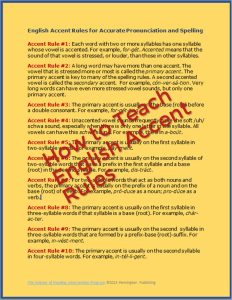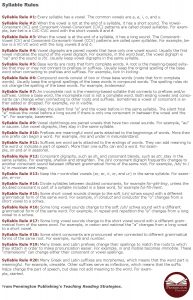Six Simple Steps to Teaching Spelling
Grades 4-8 spelling instruction was once relegated to editing stage of the writing process by some Writers Workshop purists. The Common Core authors would seem to concur. From grade 5 on up, the only Spelling Standards read as follows: CCSS.ELA-Literacy.L.4.2e ; CCSS.ELA-Literacy.L.5.2e Spell grade-appropriate words correctly, consulting references as needed. CCSS.ELA-Literacy.L.6.2b ; CCSS.ELA-Literacy.L.7.2b ; CCSS.ELA-Literacy.L.8.2b Spell correctly.
However, many veteran grades 4-8 teachers still teach spelling, especially in terms of spelling patterns, conventional spelling rules, derivational and etymological influences, accent placements and vowel shifts because they know how structural word analysis facilitates proper use of our language, better reading comprehension, and improved writing.
Plus, when you know your students still can’t spell the there, their, and they’re words, someone’s gotta teach ’em!
So, what’s the most efficient, research-based methodology to teach spelling in the fewest number of instructional minutes per week?
Six Simple Steps to Teaching Spelling:
Monday
1. Administer a weekly diagnostic pretest of 20 words based upon a focus spelling pattern: not a silly holidays, colors, or “ed” word themed list. Check out my grades 4-8 spelling patterns instructional scope and sequence for guidance. Briefly explain the weekly spelling pattern with examples. Display the spelling words and direct students to self-correct their spelling errors by circling the misspelled sound-spellings.
Tuesday
2. Have students create their own Personal Spelling List of 10 unknown words. Students complete the Personal Spelling List in this priority order:
- Pretest Errors: Have students write the spelling words they missed on the diagnostic pretest.
- Posttest Errors: Have students write the words they missed on the last posttest.
- Writing Errors: Have students add on teacher-corrected spelling errors found in their own writing.
- Supplemental Spelling Lists: Students add on unknown words from non-phonetic outlaw words, commonly confused homonyms, spelling demons, and high frequency lists. I provide these in my spelling programs or teachers can simply do a web search to find appropriate lists for your students.
Wednesday
3. Create or purchase (Yes, my program has them) a spelling sort based upon the spelling pattern. Students complete the sort and self-correct to learn from their own mistakes.
Thursday
4. Individualize Spelling Instruction
- Administer a spelling patterns diagnostic assessment, not a random sample spelling inventory. Feel free to use my 102 word Diagnostic Spelling Assessment and recording matrix for each student, post the matrix and print the number of Spelling Pattern Worksheets according to the results and amount of students in your class. Here’s an audio version to make you really love this assessment 🙂
- Print the answers to these worksheets in a half-dozen Answer Booklets.
- Students complete a worksheet, self-correct and edit the practice section, and then complete the formative assessment at the bottom of each worksheet. Want to see some samples? Download the following six Spelling Pattern Worksheets including short schwa, long schwa, “_able,” “_ible,” “_ant-ance-ancy,” and “_ent-ence-ency” spelling patterns (with answers).
Get the Spelling Pattern Worksheets FREE Resource:
![]()
- Students mini-conference about the spelling pattern focus of the worksheet. If the student has mastered the spelling pattern in the formative assessment, direct the student to X-out the slash on the matrix and assign points. If the formative assessment indicates that the student has not yet mastered the spelling pattern, re-teach the pattern and tell the student to re-do the formative assessment.
5. Students study their Personal Spelling List(s) for the spelling formative posttest for homework.
Friday
6. Administer a weekly or bi-weekly posttest. Many teachers elect to give the spelling posttest at the end of the week; others choose to combine two spelling patterns lessons and include these as part of the bi-weekly unit test. I give a bi-weekly test of two Personal Spelling Lists to save class time. There is no law, nor research, saying that you have to test each Friday. To administer the weekly or bi-weekly posttest, direct students to take out a piece of binder paper, find a partner, and exchange dictation of their Personal Spelling List(s) words (10‒20 Minutes weekly or bi-weekly). Students then turn in their posttests for the teacher to grade. I know… you think they’ll cheat. In my experience, very few do. Also… this works with second graders (I’ve done it) on up.
The author’s Differentiated Spelling Instruction provides quality spelling programs for grades 3, 4, 5, 6, 7, and 8. Both American English and Canadian English versions. Following are the program components:
- Diagnostic Spelling Assessment: a comprehensive test of each previous grade level spelling pattern to determine what students know and what they don’t know with Spelling Assessment Mastery Matrix
- 102 Remedial Sound-Spelling Worksheets Corresponding to the Diagnostic Spelling Assessment (Grade 8… other grade levels have fewer to correspond with grade-level spellings. All grade levels use the same diagnostic assessment.)
- Weekly Diagnostic Spelling Tests
- Weekly Spelling Sort Worksheets for Each Spelling Pattern (with answers) formatted for classroom display. Students self-correct to learn from their own mistakes.
- Syllable Transformers and Syllable Blending formatted for classroom display and interactive instruction
- Syllable Worksheets (with answers) formatted for classroom display
- Four Formative Assessments (given after 7 weeks of instruction)
- Summative Assessment
- Spelling Teaching Resources: How to Study Spelling Words, Spelling Proofreading Strategies for Stories and Essays, Syllable and Accent Rules, Outlaw Words, 450 Most Frequently Used Words, 100 Most Often Misspelled Words, 70 Most Commonly Confused Words, Eight Great Spelling Rules, Memory Songs and Raps (with Mp3 links), and Spelling Review Games
Read one of our customer testimonials: “I work with a large ELL population at my school and was not happy with the weekly spelling tests, etc. Through my research in best practices, I know that spelling patterns and word study are so important at this age group. However, I just couldn’t find anything out there that combines the two. We have just adopted RtI at my school and your spelling matrix is a great tool for documentation. The grade level spelling program and remediation are perfect for my students.”
Heidi






